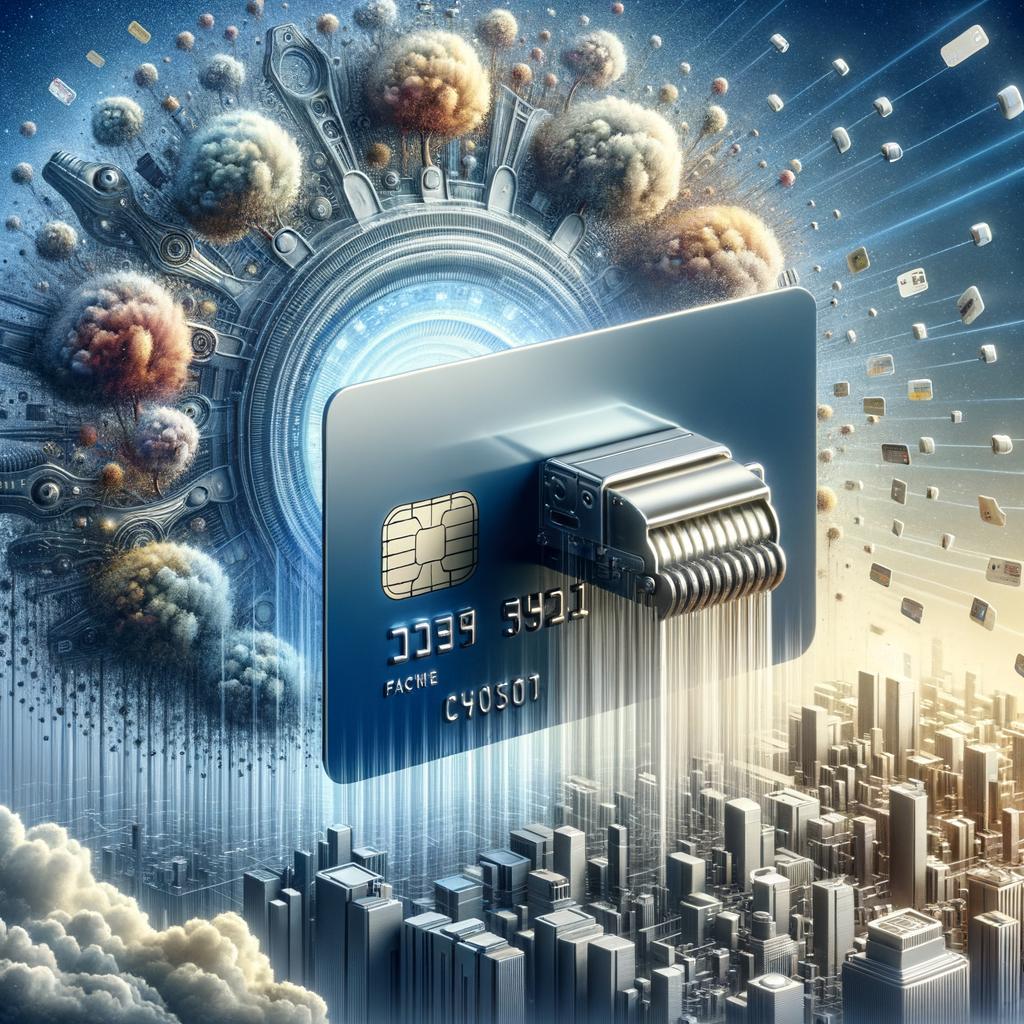Card Security and Fraud Prevention:
Card Security and Fraud Prevention: Information on security measures, fraud detection, and prevention techniques in card processing.
In today’s rapidly evolving business landscape, staying ahead of the curve is essential to success. With the rise of online transactions and digital payments, ensuring the security of customer data has become more important than ever. New payment security trends are constantly emerging, and businesses need to be aware of these developments to protect themselves and their customers.
One of the latest trends in payment security is the use of biometric authentication. Biometrics, such as fingerprint and facial recognition technology, offer a more secure and convenient way for customers to verify their identities when making payments. By incorporating biometric authentication into their payment processes, businesses can enhance security and reduce the risk of fraud.
Another key trend in payment security is the adoption of tokenization. Tokenization involves replacing sensitive payment data with a unique token that cannot be used for fraudulent purposes. This helps to protect customer information during transactions and reduces the risk of data breaches. Many payment processors now offer tokenization services to help businesses safeguard their payment processes.
Additionally, artificial intelligence (AI) and machine learning are being used to enhance payment security. These technologies can analyze large volumes of data in real time to detect fraudulent patterns and prevent unauthorized transactions. By harnessing the power of AI, businesses can improve their fraud detection capabilities and protect themselves against cyber threats.
It is important for businesses to stay informed about the latest trends in payment security and take proactive measures to safeguard their customers’ data. By implementing biometric authentication, tokenization, and AI-powered fraud detection tools, businesses can minimize the risk of security breaches and build trust with their customers. In today’s digital age, payment security is not just a priority – it’s a necessity.
If you’ve ever experienced the frustration of your card being used fraudulently, you’re not alone. In today’s digital age, card fraud is becoming increasingly prevalent, making it more important than ever to understand the liability shift that occurs in these situations.
So, what exactly is the liability shift in fraudulent card transactions? Simply put, it’s the shift in responsibility from the cardholder to the card issuer or merchant when a fraudulent transaction takes place. In the past, cardholders were often left holding the bag when their cards were used without their authorization. However, with the introduction of chip technology and EMV cards, the liability for fraudulent transactions has shifted to the party who has not adopted these security measures.
But how does this shift in liability actually work? Well, it all comes down to who is more equipped to prevent fraud in a transaction. With EMV technology, the chip in your card creates a unique code for each transaction, making it much harder for fraudsters to clone your card or steal your information. Because of this added security measure, if a fraudulent transaction occurs on a chip-enabled card, the liability falls on the party that has not implemented this technology – usually the merchant.
Understanding the liability shift in fraudulent card transactions is crucial for both cardholders and merchants. As a cardholder, it means you can rest assured knowing that you won’t be held responsible for fraudulent charges on your EMV card. And as a merchant, it’s a reminder of the importance of investing in secure payment processing technology to protect both your customers and your business.
So, next time you swipe or dip your card, take a moment to appreciate the added security that comes with EMV technology. And remember, when it comes to fraudulent transactions, knowledge is power – and understanding the liability shift is the first step in protecting yourself and your finances.
In a world where credit card fraud and data breaches seem to be an all too common occurrence, the importance of regular security audits for payment systems cannot be stressed enough. These audits are not just a routine checkup for your business – they are a vital step in ensuring the protection of your customers’ sensitive information and the reputation of your company.
Imagine this: you’ve just finished making a purchase online and you receive a notification that your credit card information has been compromised. How would you feel? Angry, frustrated, violated? Now, put yourself in the shoes of the business that failed to secure their payment systems properly – they not only face the wrath of their customers but also the potential loss of trust and credibility.
This is where regular security audits come in. By conducting these audits on a consistent basis, businesses can identify and address any vulnerabilities in their payment systems before they are exploited by malicious actors. This proactive approach not only protects the business and its customers but also saves them from costly data breaches and legal repercussions.
Furthermore, regular security audits can help businesses stay compliant with industry regulations and standards, such as the Payment Card Industry Data Security Standard (PCI DSS). Failure to comply with these regulations can result in hefty fines and damage to the business’s reputation.
So, whether you are a small e-commerce shop or a large enterprise, investing in regular security audits for your payment systems is a must. It is not just about protecting your bottom line – it is about protecting the trust and loyalty of your customers. After all, in today’s digital age, a strong security posture is the foundation of a successful business.
In today’s digital age, ensuring the security of card processing systems is more crucial than ever. With the increasing number of cyber threats targeting sensitive information, businesses must have a robust incident response plan in place to effectively address security breaches.
When it comes to protecting cardholder data, preparation is key. Developing an effective incident response plan involves thorough planning and coordination across all levels of the organization. From identifying potential risks to implementing mitigation strategies, every step plays a crucial role in safeguarding the integrity of card processing systems.
One of the first steps in developing a robust incident response plan is conducting a thorough risk assessment. By identifying potential vulnerabilities in the card processing system, businesses can proactively address security gaps and implement necessary measures to prevent security breaches. This includes regular security audits, penetration testing, and monitoring of system activities to detect any suspicious behavior.
In addition to identifying risks, businesses must also establish clear protocols and procedures for responding to security incidents. This includes defining roles and responsibilities within the organization, establishing communication channels for reporting incidents, and outlining escalation procedures for handling critical security breaches. By having a well-defined incident response plan in place, organizations can minimize the impact of security incidents and limit the exposure of sensitive cardholder data.
Furthermore, regular training and awareness programs are essential for ensuring that all employees are equipped with the necessary skills and knowledge to respond effectively to security incidents. By educating employees on best practices for data security and incident response, businesses can create a culture of security awareness and empower their workforce to proactively mitigate risks.
Overall, developing a robust incident response plan for card processing security breaches requires a proactive approach, thorough planning, and continuous monitoring of security measures. By prioritizing the security of cardholder data and implementing effective incident response strategies, businesses can safeguard their systems against potential threats and protect the trust of their customers.
In a world where cyber threats lurk around every digital corner, protecting sensitive information has become paramount. Enter tokenization, the latest superhero on the scene ready to save the day in the realm of card processing security.
Tokenization works its magic by replacing sensitive card data, such as card numbers, expiration dates, and security codes, with a unique string of characters, or token. This token bears no resemblance to the original data, making it virtually impossible for hackers to crack the code and steal valuable information. It’s like giving a spy a secret code to decode – good luck trying to crack that!
So how does tokenization work its wonders behind the scenes? When a card is used for a transaction, the original data is securely stored by a third-party payment processor. Meanwhile, the merchant receives the token, which is used to complete the transaction. If a hacker were to intercept the token, it would be useless to them without the original data. It’s like trying to put together a puzzle without all the pieces – good luck trying to make sense of the picture!
Tokenization not only enhances security for card processing but also provides peace of mind for both consumers and merchants. With the rise of e-commerce and digital payments, the need for robust security measures has never been greater. By implementing tokenization, businesses can rest assured that their customers’ information is securely protected, while customers can swipe their cards with confidence knowing that their data is safe from prying eyes.
In a world where digital threats loom large, tokenization offers a beacon of hope for safeguarding sensitive information in the vast expanse of cyberspace. It’s like having a digital shield protecting your card data from the dark forces of the internet. So next time you make a purchase online, rest easy knowing that tokenization is working tirelessly behind the scenes to keep your information safe and sound. Trust in the power of tokenization, the unsung hero of card processing security.
The world of credit card processing has always been a bit of a wild west, brimming with tales of dastardly hackers and sneaky fraudsters. But fear not, dear reader, for a new hero has emerged to protect our financial sovereignty – EMV chip technology!
Gone are the days of swiping our cards, crossing our fingers, and hoping for the best. With the implementation of EMV chip technology, we can now rest easy knowing that our card transactions are as secure as Fort Knox.
So, what exactly is this EMV chip technology, you ask? Well, my curious friend, it’s a tiny chip embedded in your credit or debit card that revolutionizes the way your transactions are processed. And boy, does it pack a punch!
This little chip is like a bouncer outside a trendy club, meticulously scrutinizing every transaction that comes its way. It uses advanced cryptographic algorithms to authenticate and encrypt your card data, ensuring that only the true owner can gain access to your financial kingdom.
Picture this: you’re strolling through your favorite boutique, about to indulge in a shopping spree. As you approach the counter, instead of the usual swipe, the friendly cashier asks you to insert your card into a terminal equipped with EMV technology. You confidently oblige, knowing that the days of magnetic strip shenanigans are behind you.
The magic happens within a split second. The EMV chip in your card and the terminal engage in a secret handshake, silently exchanging encrypted information that leaves would-be thieves scratching their heads in frustration. This intricate ballet of encryption ensures that your sensitive data remains safely tucked away, far from the prying eyes of cybercriminals.
But the wonders of EMV chip technology don’t stop there. This caped crusader also comes with a nifty sidekick called dynamic transaction codes. Unlike those outdated magnetic stripes that always spilled the same digits, EMV creates a unique code for every single transaction you make.
Think of it as your card playing a round of 20 questions with the terminal. Each time you make a purchase, the card generates a new code that is only valid for that specific transaction. So, even if a crafty hacker manages to intercept your code, they won’t be able to use it again. It’s like having a digital cloak of invisibility that keeps your funds safe and sound.
Now, you may be wondering why we haven’t fully adopted this superheroic technology in every nook and cranny of the card processing universe. It turns out that transitioning to EMV chip technology is a bit of a Herculean task. In addition to new card designs, merchants need to invest in updated payment terminals that can accommodate these tiny yet powerful chips.
But fear not! As the world collectively puts on its cape and embraces the power of EMV, we can expect to see a drastic reduction in credit card fraud. And hey, isn’t that a future worth fighting for?
So, my dear reader, rejoice in the knowledge that the days of clenching your fists and holding your breath every time you hand over your card are behind you. EMV chip technology is here to save the day, one secure transaction at a time.
PCI Compliance: What It Means and Why It Matters for Your Business
So, you’ve started your own business, and you’re ready to take the world by storm. You have an amazing website set up, a smooth checkout process, and plenty of customers eager to hand over their hard-earned cash. But have you ever stopped to think about how secure your customers’ payment information really is?
If you haven’t, it’s time to buckle up and dive into the world of PCI compliance – a term that may sound complicated, but trust me, it’s crucial for the success of your business.
Picture this: you stroll into a fancy restaurant, ready to indulge in a mouthwatering meal. As you make your way to your table, you glance back to see your credit card information scattered on the floor for anyone to grab. Not an ideal scenario, right? Well, that’s exactly what could happen if your business fails to comply with PCI standards.
PCI compliance, or the Payment Card Industry Data Security Standard (try saying that ten times fast!), is a set of security standards established by the major credit card companies – Visa, Mastercard, American Express, and Discover – to ensure that businesses handle payment card information securely. But, you may ask, why should I care about this jumble of acronyms?
Well, my friend, not only does being PCI compliant protect your customers’ sensitive data, but it also protects your business from hefty fines, lawsuits, and most importantly, a damaged reputation. Imagine if word got out that your website wasn’t secure, or worse, that your business was involved in a major data breach. You’d have customers fleeing faster than a cheetah chasing its lunch, that’s for sure.
Now, you might be asking, “But how do I achieve PCI compliance?” Excellent question, my curious entrepreneur. First, you need to assess your business’s processes and systems to identify any areas of vulnerability. Are you using outdated software? Is your data stored securely? What about your employees – are they trained on handling sensitive information?
Once you’ve pinpointed any potential weaknesses, it’s time to take action. Implement the necessary security measures and train your employees on safe practices. This may include using encryption to protect data, regularly updating your software, and limiting access to payment card information only to those who truly need it.
But remember, achieving PCI compliance isn’t a one-time event; it’s an ongoing process. You’ll need to continually assess and update your security measures to stay ahead of the ever-evolving threat of cybercrime. Just like you wouldn’t leave your mansion unlocked at night, you can’t afford to relax when it comes to protecting your customers’ payment information.
So, my ambitious business owner, let’s sum it all up. PCI compliance is not only about safeguarding your customers’ data but also protecting your business from potential disaster. By ensuring that your business meets the necessary security standards, you can sleep soundly knowing that your customers trust you and your reputation remains intact.
Remember, in the ever-changing world of business, where hackers lurk around every digital corner, being PCI compliant isn’t just an option – it’s a necessity. Secure those credit cards, lock up those passwords, and watch your business flourish while keeping cybercriminals at bay.
In this day and age, our smartphones have become more than just a device to make calls or send text messages. They have transformed into digital powerhouses that can handle almost any task we throw at them — including mobile payments. With just a tap of a finger, we can now conveniently pay for our morning coffee, movie tickets, or even groceries. But as with any convenience, there are always risks involved, and securing these mobile payments is no exception.
One of the biggest challenges faced when it comes to securing mobile payments is the vulnerability of our smartphones. These little gadgets carry a wealth of personal and financial data, making them a prime target for cybercriminals. Any lapse in security can lead to disastrous consequences, such as unauthorized transactions, identity theft, and financial loss. So, how can we address this challenge and ensure the safety of our mobile payments?
One solution lies in the development of secure payment technologies. Companies and financial institutions are continuously investing in state-of-the-art encryption methods, biometric authentication systems, and tokenization techniques to safeguard our transactions. From using fingerprints or facial recognition to verify our identities to generating unique tokens for every transaction, these advancements are making it increasingly difficult for hackers to infiltrate our mobile payments.
Another crucial aspect of securing mobile payments is user awareness and education. Technology is evolving at a rapid pace, and it is essential for users to stay informed about the latest security threats and techniques. By understanding the risks and being cautious of phishing attempts, suspicious apps, or unsecured networks, we can take proactive steps to protect ourselves.
Furthermore, financial institutions and app developers need to collaborate to establish robust security protocols. Implementing multi-factor authentication, requiring strong passwords, and regularly updating security patches are just a few measures that can be taken to mitigate risks. Regular audits and vulnerability assessments should also be conducted to identify any weaknesses and patch them before they can be exploited.
While the responsibility of securing mobile payments primarily lies with the users and the payment service providers, government regulations also play a vital role. Governments need to foster an environment that encourages innovation while also ensuring stringent security standards. By setting regulations and enforcing compliance, they can help create a safer ecosystem for mobile payments.
Securing mobile payments may seem like a daunting task, but with the right combination of advanced technologies, user awareness, collaboration, and regulatory support, it can be achieved. As we continue to rely more heavily on our smartphones for financial transactions, it is imperative that we prioritize the security of our mobile payments. By doing so, we can enjoy the convenience while keeping our personal and financial data safe from prying eyes in the digital realm.
In an era where cyber threats are lurking at every corner of the digital world, ensuring the security of our financial transactions is of paramount importance. With the increasing prevalence of card payments, it’s high time we explore innovative solutions that can enhance the security of card processing.
Enter blockchain technology, the buzzword that has taken the tech industry by storm. Stemming from the concept of decentralization and immutability, blockchain offers a promising avenue for bolstering card processing security like never before. Let’s delve into the potential ways through which this groundbreaking technology can revolutionize the way we transact with our plastic buddies.
One of the most significant benefits of blockchain is its ability to prevent fraud. Traditional methods of card processing rely on centralized systems that store sensitive transaction data in a vulnerable manner. By leveraging blockchain, we can decentralize these records, essentially eliminating the possibility of tampering or altering transactions. Each card processing transaction could be recorded as a unique block on the chain, making it virtually impossible for hackers to interfere with the data in any malicious way.
Additionally, blockchain technology can render financial institutions and merchants less reliant on storing vast amounts of sensitive customer information. Storing this information centrally poses a substantial risk, considering the countless data breaches that have plagued companies in recent years. By replacing personal details with anonymous digital signatures, blockchain encryption ensures confidentiality without compromising security. This way, even if a breach were to occur, hackers would find themselves empty-handed, unable to access any personally identifiable information.
Imagine a scenario where you have recently made a card payment and are anxious about the security of your transaction. In the traditional banking system, you must trust the intermediary, such as a bank or payment processor, to ensure the integrity of the transaction. Blockchain, on the other hand, eliminates the need for intermediaries, as it embraces a peer-to-peer network of trust. By cutting out the middleman, blockchain technology puts power back into the hands of consumers, instilling confidence by providing an unbreakable chain of trust.
Moreover, blockchain can streamline cross-border card processing, minimizing costs and eliminating intermediary fees. The decentralized nature of blockchain removes the need for lengthy, convoluted clearance processes, reducing transaction times from days to minutes. This enhanced efficiency not only benefits customers but also empowers businesses, allowing them to improve cash flow and allocate resources elsewhere. The cost savings and increased transparency brought about by blockchain technology can be a welcome relief for both consumers and businesses alike.
Although blockchain technology offers an array of advantages, it is not without its challenges. Scalability and slow transaction speeds have long been concerns within the blockchain community. However, progress is being made, with new solutions such as sharding and layer 2 protocols on the horizon. As these obstacles are overcome, blockchain’s potential to revolutionize card processing security becomes increasingly apparent.
In conclusion, card processing security is a pressing issue in today’s digital landscape, and blockchain technology emerges as a beacon of hope. With its decentralized and immutable nature, blockchain has the potential to thwart fraudulent activities, reduce reliance on centralized storage, and bring trust back into transaction processes. By embracing this innovative technology, we can pave the way for a more secure and transparent future in the world of card processing.
Do you know that feeling of panic that rushes over you when you receive a call from your bank, informing you about suspicious activity on your credit card? Your mind starts racing, trying to remember every purchase and transaction you’ve made recently. How could this have happened? How did they manage to get hold of your card details? Well, fear not my friends, for the world of card processing has advanced leaps and bounds in the fight against fraud.
Gone are the days when fraudsters could easily get away with their ill-gotten gains. With the emergence of sophisticated fraud detection techniques, businesses and card processing companies are now equipped with powerful tools to safeguard our hard-earned money.
So, what exactly are these advanced fraud detection techniques that make it increasingly difficult for criminals to pull off their scams? Let’s dive into this fascinating world of technology and deception!
First and foremost, we have machine learning algorithms. These algorithms are no less than superheroes, tirelessly analyzing vast amounts of data to identify patterns and anomalies that could indicate fraudulent activity. They use historical transaction data as a baseline to detect any deviations from the norm, immediately raising red flags for further investigation.
Next up in our arsenal against fraudsters are artificial intelligence (AI) systems. These cutting-edge technologies have the ability to mimic human intelligence and decision-making processes, but with lightning-fast speed and unmatched accuracy. Utilizing AI, card processing companies can accurately differentiate between legitimate transactions and fishy ones, ensuring that only the good guys get the green light.
But wait, there’s more! Biometric authentication is yet another powerful tool in the fight against card fraud. With the rise of fingerprint and facial recognition technology, financial institutions can verify the identity of individuals with a degree of certainty that was once unimaginable. No more worries about someone stealing your physical card and going on a shopping spree!
Last but certainly not least, we have the power of big data. By pooling together massive amounts of information about cardholders, their spending habits, and geographic patterns, card processing companies can quickly identify unusual behavior and swiftly take action. So, if a fraudster suddenly starts making purchases on your card in another country, you can be sure that an alert will be raised faster than you can say “cancel my card.”
In conclusion, the battle against fraud in card processing has taken a dramatic turn in favor of the good guys. With the help of advanced fraud detection techniques such as machine learning algorithms, AI systems, biometric authentication, and the power of big data, criminals have found themselves up against an impenetrable fortress. So, next time you receive that dreadful call from your bank, take a deep breath and rest easy knowing that the heroes of technology are hard at work, protecting your money from the clutches of fraudsters.











